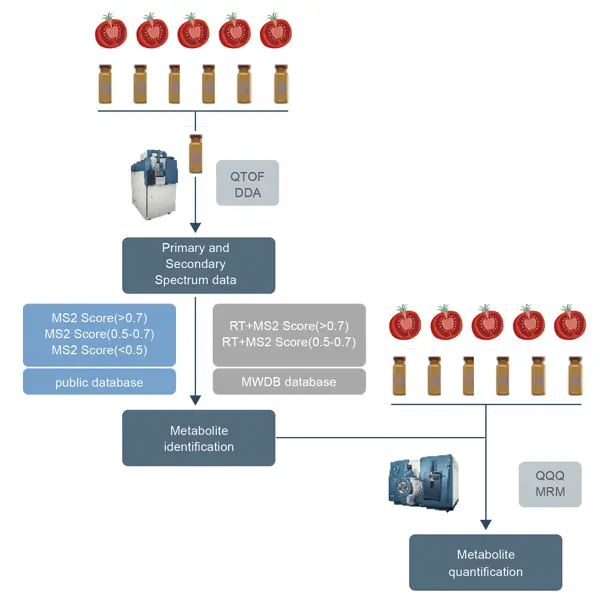Widely-Targeted Metabolomics for Plants
Widely-Targeted Metabolomics for Plants
Technology Introduction
- Using high-resolution mass spectrometers to allow the unbiased collection of MS/MS spectrum data;
- Highly curated in-house metabolomics database (MWDB) that provides accurate metabolite identification;
- Using MRM analysis for plant metabolome from QQQ based on LC-MS to accurately quantify metabolites in each sample.

Technical Features of Widely-Targeted Metabolomics for Plants
Metabolomics in Plants Analytical Techniques
- ABSciex Triple TOF 6600+ (HR-MS)
- ABSciex QTRAP6500+
- ABSciex QQQ6500
Applications of Widely-Targeted Metabolomics in Plants
Applicable for research in plant response to:
Abiotic stress: light (UV), water (drought, waterlogging), heavy metals (cadmium, lead, etc.), temperature (high temperature, low temperature), mechanical damage and other external factors bring reversible or irreversible effects on plants.
Biological stress: the influence of insects, bacteria, fungi, and viruses on the growth and development of plants.
Article Spotlight: Analysis of Global Methylome and Gene Expression during Carbon Reserve Mobilization in Stems under Soil Drying
In this study, the researchers looked at high-resolution DNA methylome in rice (Oryza sativa) during moderate soil drying (MD) conditions. They found a hypermethylated/up-regulated transcription factor of MYBS2 inhibited MYB30 expression and possibly enhanced β-Amylase5 expression, promoting subsequent starch degradation in rice stems under MD treatment. In addition, a hypermethylated/down-regulated transcription factor of ERF24 was predicted to interact with, and thereby decrease the expression of, abscisic acid 8'-hydroxylase1, thus increasing abscisic acid concentration under MD treatment.
Applicable for examining metabolites associated with crop phenotypes such as yield, grain width, grain color, nutrient composition, plant height, lodging resistance, fruit size, fruit color, taste, and many selected traits.
Article Spotlight: UDP-glucosyltransferase regulates grain size and abiotic stress tolerance associated with metabolic flux redirection in rice
Researchers characterized GSA1, a gene that regulates grain size and abiotic stress tolerance associated with metabolic flux redirection by exhibiting glucosyltransferase activity toward flavonoids and monolignols. GSA1 regulates grain size by modulating cell proliferation and expansion, which are regulated by flavonoid-mediated auxin levels and related gene expression. GSA1 is required for the redirection of metabolic flux from lignin biosynthesis to flavonoid biosynthesis under abiotic stress and the accumulation of flavonoid glycosides, which protect rice against abiotic stress. GSA1 overexpression results in larger grains and enhanced abiotic stress tolerance.
Article Spotlight: Identification of key taste components in loquat using widely targeted metabolomics
The researchers tackle the question of why white-fleshed loquats taste better by performing LC-MS/MS-based widely targeted metabolome analysis. A total of 536 metabolites were identified, 193 of which (including 7 carbohydrates, 12 organic acids, and 8 amino acids) were different between the cultivars. Pathway enrichment analysis also identified significant differences in phenolic pathways between the cultivars. Our results suggest that taste differences between the cultivars can be explained by variations in composition and abundance of carbohydrates, organic acids, amino acids, and phenolics.
Case Study of Widely-Targeted Metabolomics in Plants
| Number Of Metabolites In Different Classes | |||
| Carbohydrates | 450 | Phenolic acids | 2500 |
| Alkaloids | 8500 | Quinones | 1000 |
| Amino acid | 800 | Steroids | 1600 |
| Coumarins | 1500 | Tannins | 400 |
| Flavonoids | 7800 | Terpenes | 12,000 |
| Lignans | 1100 | Vitamins | 50 |
| Lipids | 900 | Glucosinolates | 200 |
| Nucleotides | 300 | Others | 3200 |
| Organic acids | 2100 | Total | 61,150 |
Analysis Content Display of Widely-Targeted Metabolomics for Plants Service
Next-Generation Omics Solutions:
Proteomics & Metabolomics
Ready to get started? Submit your inquiry or contact us at support-global@metwarebio.com.


